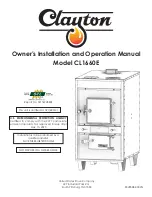
8 18-CD34D1-5-EN
INSTALLER’S GUIDE
If the furnace is suspended using perforated steel strap (plumber’s
strap), it must be supported at all four corners and in the middle
at the front of the furnace. The forward most screw on the side
of the furnace may be used to connect the strapping (See Figure
6). Line contact is only permissible between lines formed by the
intersection of the top and two sides of the furnace casing and the
building joists, studs, or framing.
TYPICAL UPFLOW/HORIZONTAL ATTIC INSTALLATION
5
A cutout is provided on both sides of the downflow furnace
cabinet to allow a 90° elbow to be attached inside the cabinet
and the vent piping to connect there. In horizontal, the downflow
furnace may be vented through the top of the cabinet if needed.
In vertical configuration, the downflow furnace may be vented
using the side cabinet cutouts. This venting configuration could
be used if an electronic air cleaner is installed.
When the downflow furnace is vented through the left side
of the furnace cabinet in horizontal or vertical configuration,
Type B vent pipe must be used within the cabinet.
Typical Suspended Upflow/Horizontal Furnace
6
50 CU. FT. OR MORE
PER 1000 BTU/HR.
INPUT ALL EQUIP.
INSTALLED
UNCONFINED
7
AIR FOR COMBUSTION AND
VENTILATION
Adequate flow of combustion and ventilating air must not be
obstructed from reaching the furnace. Air openings provided in
the furnace casing must be kept free of obstructions which restrict
the flow of air. Airflow restrictions affect the efficiency and safe
operation of the furnace. Keep this in mind should you choose
to remodel or change the area which contains your furnace.
Furnaces must have a free flow of air for proper performance.
Provisions for combustion and ventilation air shall be made
in accordance with “latest edition” of Section 5.3, Air for
Combustion and Ventilation, of the National Fuel Gas Code,
ANSI Z223.1, or Sections 7.2, 7.3 or 7.4 of CAN/ CGA B149
Installation Codes, and applicable provisions of the local building
codes. Special conditions created by mechanical exhausting of
air and fireplaces must be considered to avoid unsatisfactory
furnace operation.
Furnace locations may be in “confined space” or “unconfined
space”. Unconfined space is defined in Table 2 and Figure 7.
These spaces may have adequate air by infiltration to provide air
for combustion, ventilation, and dilution of flue gases. Buildings
with tight construction (for example, weather stripping, heavily
insulated, caulked, vapor barrier, etc.), may need additional air
provided as described for confined space.
Confined spaces are installations with less than 50 cu. ft. of space
per 1000 BTU/hr input from all equipment installed. Air for
combustion and ventilation requirements can be supplied from
inside the building as in Figure 9 or from the outdoors, as in
Figure 10.
LESS THAN 50 CU.
FT. PER 1000 BTU/
HR. INPUT ALL EQUIP
INSTALLED
CONFINED
8
1.
All air from inside the building as in Figure 9: The
confined space shall be provided with two permanent
openings communicating directly with an additional
room(s) of sufficient volume so that the combined volume
of all spaces meets the criteria for an unconfined space.
The total input of all gas utilization equipment installed
in the combined space shall be considered in making this
determination. Refer to Table 3, for minimum open areas
required.
2.
All air from outdoors as in Figure 10: The confined
space shall be provided with two permanent openings,
one commencing within 12 inches of the top and one
commencing within 12 inches of the bottom of the
enclosure. The openings shall communicate directly, or
by ducts, with the outdoors or spaces (crawl or attic) that
freely communicate with the outdoors. Refer to Table 3,
for minimum open areas required.


































